Process management is a discipline for managing work across the organization to achieve efficient and adaptable business operations. After all, efficiency is not just a strategy - it's necessary to thrive in a competitive landscape.
In this article, we’ll dive into the essentials of process management, exploring the transformative impact of streamlined workflows and standardized procedures while staying atop the ever-evolving customer expectations.
What Is Process Management?
Process management is a systematic approach to managing a collection of related tasks to achieve a specific goal for an organization. For instance, the way a restaurant manages order-taking, food preparation, and service is a process that must be efficient to ensure customer satisfaction. Similarly, in an organization, processes like risk management ensure potential threats are identified, assessed, and mitigated, preventing disruptions.
The PMI Guide to the Project Management Body of Knowledge (PMBOK® Guide) defines a process as a series of activities that transform inputs into outputs, emphasizing its structured nature. It also highlights that processes involve taking inputs such as resources, information, or materials and transforming them into outputs such as products, services, or outcomes.
Here are some important characteristics of process management:
-
A Structured Way of Thinking: Process management encourages a systematic approach to analyzing team operations within a work environment. By thinking systematically, you can uncover inefficiencies, streamline operations, and improve overall performance.
-
A Common Language: It provides a shared vocabulary of terms, concepts, theories, and methodologies that help teams discuss and analyze their work experiences. This common language allows for better communication, collaboration, and problem-solving across departments.
-
Problem-Solving Techniques: Process management equips organizations with techniques to address common issues in the workplace, such as bottlenecks, miscommunication, and misalignment. These tools enable teams to tackle challenges more effectively and create smoother workflows.
Why Is Process Management Important?
Process management is pivotal in ensuring business activities are carried out efficiently and effectively. Using a structured approach, you can systematically plan, execute, and analyze how you deliver results. This helps achieve project goals and fosters organizational learning, allowing continuous improvement over time.
Key Benefits of Process Management
-
Cost Savings: Streamlining processes reduces waste and unnecessary steps, lowering operational costs.
-
Increased Productivity: Well-defined processes allow teams to work more efficiently, avoiding bottlenecks.
-
Better Quality Control: A systematic approach ensures consistent standards, leading to higher quality outcomes.
-
Improved Customer Satisfaction: Faster, more reliable processes enhance the customer experience.
-
Standardization: Process management establishes clear guidelines, making replicating success across teams or departments easier.
For example, in the retail industry, process management in product development and industrialization ensures that every phase - from concept design to mass production - is optimized. This results in faster product launches, reduced manufacturing costs, and higher-quality goods, all while meeting market demand more efficiently and improving the overall customer experience.
One such example is a company in the fashion industry that uses work management boards in Businessmap to ensure smooth project transitions and timely delivery. To achieve their goals, they created custom boards where they efficiently track prototypes, manage priorities, and use color-coded systems to prioritize tasks and streamline their work.

5 Key Prerequisites for Effective Process Management
To achieve optimal business performance, it's crucial to have a few foundational elements in place. Here are five key prerequisites for effective process management:
1. Visualizing Value Streams through Mapping Techniques
Process mapping tools, like whiteboards, help teams visualize each workflow step, including active and idle stages. This approach enhances understanding of work delivery methods and reveals areas for improvement.

2. Elimination of Non-Value-Added Activities
Identifying and removing inefficiencies from your workflow will help you streamline operations. By mapping all the steps in a workflow, including the steps of the process where external dependencies happen and work is in a "queue" phase, you can gain a clearer insight into the actual efficiency of how you deliver work. Visualizing every step in the process, including bottlenecks and dependencies, can uncover hidden issues, such as miscommunication and bottlenecks, and improve collaboration.

3. Process Standardization
Standardizing processes across the organization ensures reliability, minimizes errors, and makes scaling much smoother. At Businessmap, we often see clients struggling with disjointed activities across teams. Tasks like information retrieval, order processing, and supplier follow-up are frequently managed through inconsistent methods, often relying on scattered records in Excel sheets. Standardization brings order and predictability, making processes more efficient.
4. Cross-Departmental Cooperation and Clear Process Policies
Strong collaboration across departments is essential for smooth process management. Without it, conflicts with authority and misaligned goals can disrupt workflows. For example, in international companies, multiple teams can seek information about order status or supplier delays simultaneously, leading to redundant and inaccurate data.
Implementing explicit process policies is an invaluable practice of the Kanban work management method. This method helps teams deliver results focusing on efficiency. This practice further reinforces communication and alignment in how teams deliver their work.
5. Commitment to Continuous Improvement
Maintaining flexibility and fostering a culture of continuous improvement ensures that workflows remain efficient and adaptable to change. This commitment to ongoing enhancement is vital for staying competitive and responsive in a dynamic business environment.
By implementing these five prerequisites, businesses can create a solid foundation for effective process management, driving better performance and sustained growth.
Process Management: Best Practices to Get Started
Starting with these practices provides a solid foundation for improving your process efficiency and fostering a culture of continuous improvement.
-
Map Value Streams: The first step is to clearly understand how different areas in your business are interconnected and provide customer value. One way to do this is through interactive digital whiteboards where you create process flowcharts, visualize dependencies, and map process flows.

-
Visualize Your Workflow: By implementing digital work management tools, teams see entire processes at a glance, identify bottlenecks, and understand task dependencies, which is essential for streamlining operations.
-
Limit Work In Progress (WIP): By capping the number of tasks a team is working on at any given time, you avoid overloading team members and ensure current work is completed before the new one is started.
-
Set Clear Roles and Responsibilities: Clearly define who is responsible for each part of the process. This avoids confusion, reduces handoff delays, and ensures accountability.
-
Standardize Processes: Standardization ensures consistency across teams and departments. By having well-defined procedures, you reduce errors, improve efficiency, and make scaling or replicating processes easier.
-
Monitor Key Metrics: Track workflow metrics metrics such as cycle time, lead time, and throughput to measure the efficiency of your processes. Monitoring performance allows you to make data-driven decisions and continuously optimize workflows.
-
Implement Continuous Improvement: Regularly review and refine your processes through continuous feedback and data analysis. Use workflow metrics to understand what’s working and what’s not, then make incremental improvements over time.
-
Encourage Cross-Team Collaboration: Break down silos and ensure strong communication between teams. Collaboration helps prevent delays due to misalignment or lack of information, especially in processes involving multiple departments.
Process Tools: Enhancing Process Management with Clear Visualizations and Metrics
Process tools effectively show how a process works by providing clear visual representations and process models that help managers and teams map out, implement, and refine their workflows. These tools aim to give teams a deeper understanding of how processes function, identify inefficiencies, and offer a structured approach to continuous improvement. By modeling their processes, teams can execute these models in real-world scenarios and refine them based on actual performance data.
Key Benefits of Process Management Tools
Process tools offer several essential benefits, particularly in improving transparency, centralization, and performance metrics.
Transparency into Work Management Processes
Process tools offer a transparent view of how work is managed and executed. By visually mapping out every step, team members can quickly identify bottlenecks, redundancies, or areas for improvement.
Centralization of Process Models
With process tools, all project organization models are centralized, providing a single source of truth. Centralized models ensure consistency across teams and departments, allowing for streamlined communication and more effective coordination. It also makes it easier to scale processes, as standardized models can be adapted for different teams or projects.
Execution Metrics
Process tools also provide metrics that help teams track the success of their workflows. By measuring the performance of different processes, organizations can gain valuable insights into what's working and what's not. Execution metrics - such as time spent on tasks, completion rates, and resource allocation - allow teams to make data-driven decisions. This focus on continuous improvement is critical for refining processes over time and ensuring they remain aligned with business goals.
Process Management Improvement Methods
Different process management methods offer unique ways to optimize workflows and drive efficiency, depending on the nature of the business and its goals. Here are a few essential methods widely used in process management:
-
Business Process Management (BPM): BPM is a way of visually representing processes, often through process mapping. BPM uses graphic maps and whiteboards to display each process step, making it easier to analyze and improve. The visual aspect of BPM makes it a highly effective tool for aligning team members and stakeholders on what needs to be done and when.
-
Lean Six Sigma: Lean Six Sigma focuses on eliminating waste from processes to create more value with fewer resources. The goal is to streamline operations by identifying and removing activities that don't add value to the final product or service. Using tools like root cause analysis and statistical metrics, Lean Six Sigma helps teams continuously improve by refining their processes to be faster, more cost-effective, and less prone to errors.
-
5 Whys: The 5 Whys method is a powerful process management tool for identifying the root causes of problems. By repeatedly asking "Why?" - typically five times, teams can dig deeper to uncover underlying issues. The approach promotes better understanding, reduces recurring problems, and supports continuous improvement by addressing root causes rather than surface-level fixes, making processes more resilient.
Each of these process management methods has its strengths, and the best choice depends on the nature of the business and its specific challenges. Let’s see how some of these methods have been implemented successfully.
Process Management Examples: 3 Success Stories
33% Better Operational Performance in Logistics | Encoparts
One example comes from the international purchasing division of logistics company Encoparts. The team applied Lean practices, precisely value stream mapping (VSM), to visualize and analyze their processes. The technique helped them identify where they delivered actual value in the process, uncovering inefficiencies that limited their service evolution.
By breaking down and mapping each crucial step with the help of Businessmap’s process and workflow management capabilities, they clarified where improvements were needed, leading to streamlined operations and 33% Better Operational Performance in their purchasing area. (Encoparts Case Study)

54% Cycle Time Improvement in Dairy Production Processes | AK Gida
Turkey's largest dairy producer, AK Gida, successfully optimized their processes through targeted workshops like Value Stream Mapping (VSM) and STATIK (Systems Thinking Approach to Implementing Kanban). These efforts helped streamline how new requests from business units were gathered and synthesized. By implementing a dedicated board to visualize the workflow as a "pool of ideas," the team could easily classify whether a request was a complete project or a smaller task, like a "Change Request."

To track dependencies on external vendors, they used heatmaps to track how long their work waits on a specific vendor.
The transformation efforts at AK Gida resulted in a 54% Cycle Time Improvement, a 23% reduction in lead time, and a 21% decrease in delay time caused by third-party suppliers over four months. (AK Gida Case Study)
From over 150 Days to 60 Days Average Delivery Times | Flapper
Another example comes from the air taxi marketplace - Flapper. Lack of work visibility, frequent task-switching, and slow delivery times created significant workflow disruptions. With product stability and timely delivery under threat, it became clear that workflow visibility was essential to improve predictability and alignment with business priorities.
 Average WIP (Work In Progress) of 80 items per week shown using the WIP Run Chart in Businessmap
Average WIP (Work In Progress) of 80 items per week shown using the WIP Run Chart in Businessmap
Flapper tackled workflow issues by introducing a work-in-progress (WIP) limit inspired by Kanban. This helped the team focus on high-impact tasks, avoid overload, and address bottlenecks more effectively through transparent workflows and centralized task management.
Within months, Flapper’s technology team Reduced Average Delivery Times from Over 150 days to 60, and throughput became more predictable. The WIP limits also lowered the amount of unfinished work and rework, leading to higher-quality product delivery. (Flapper Case Study)
 Average WIP (Work In Progress) drop shown after implementing the practice of limiting work
Average WIP (Work In Progress) drop shown after implementing the practice of limiting work
Businessmap is the most flexible software
to align work with company goals





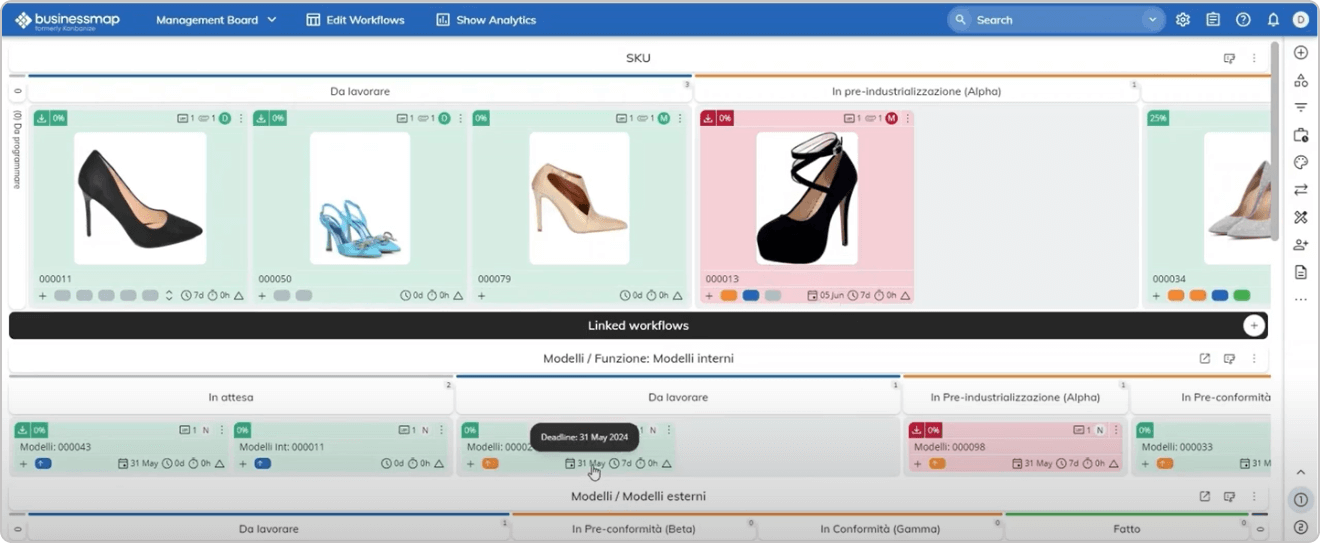
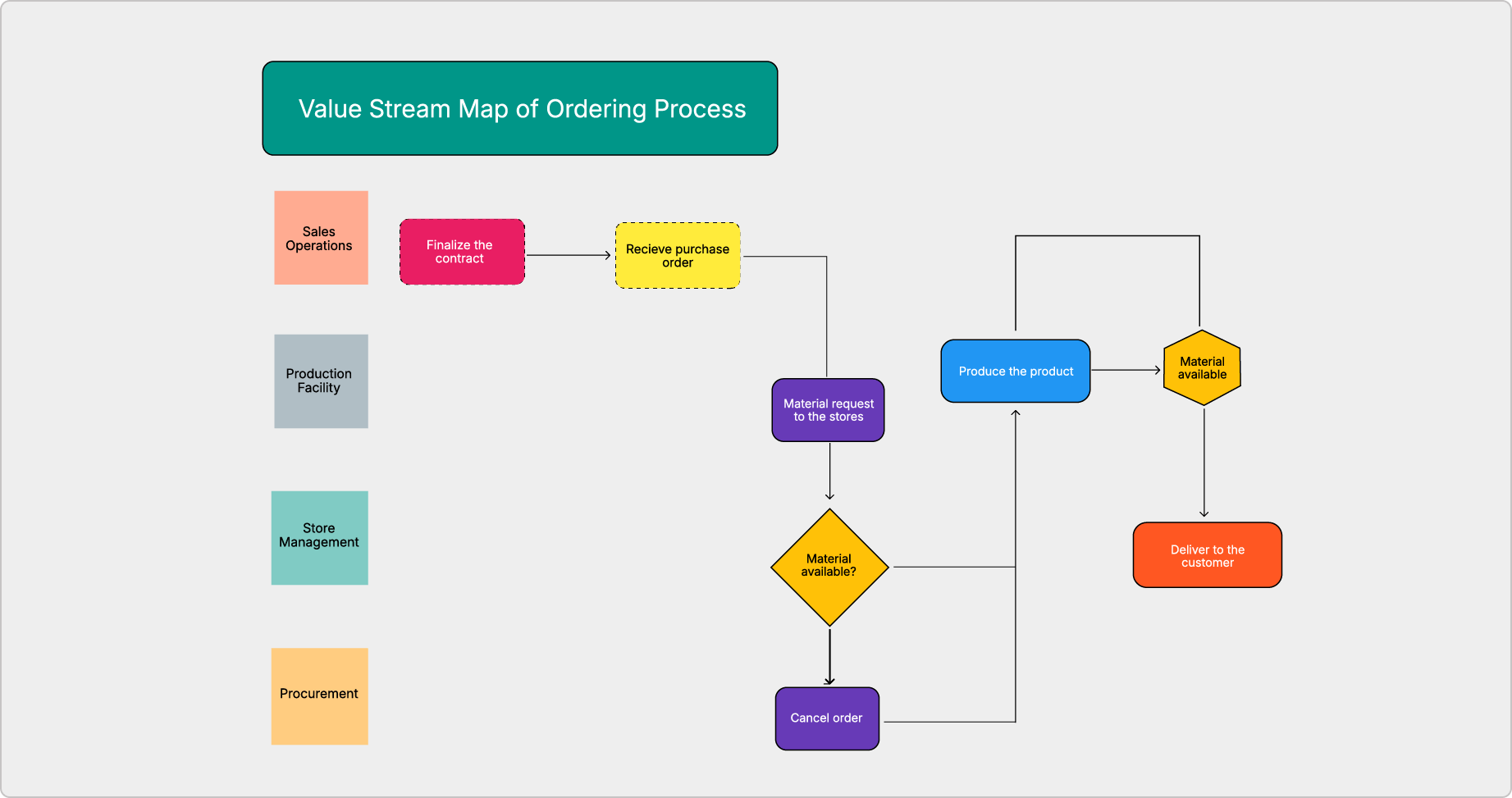
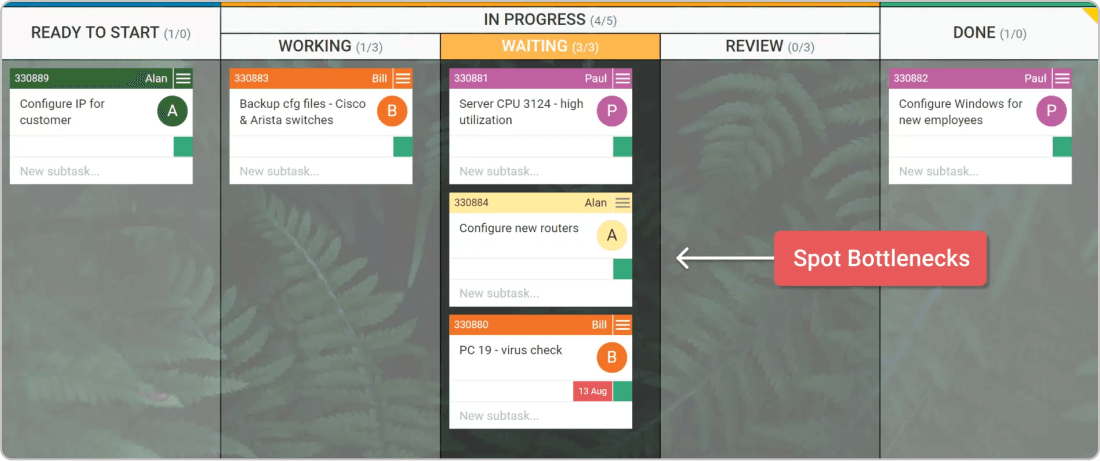
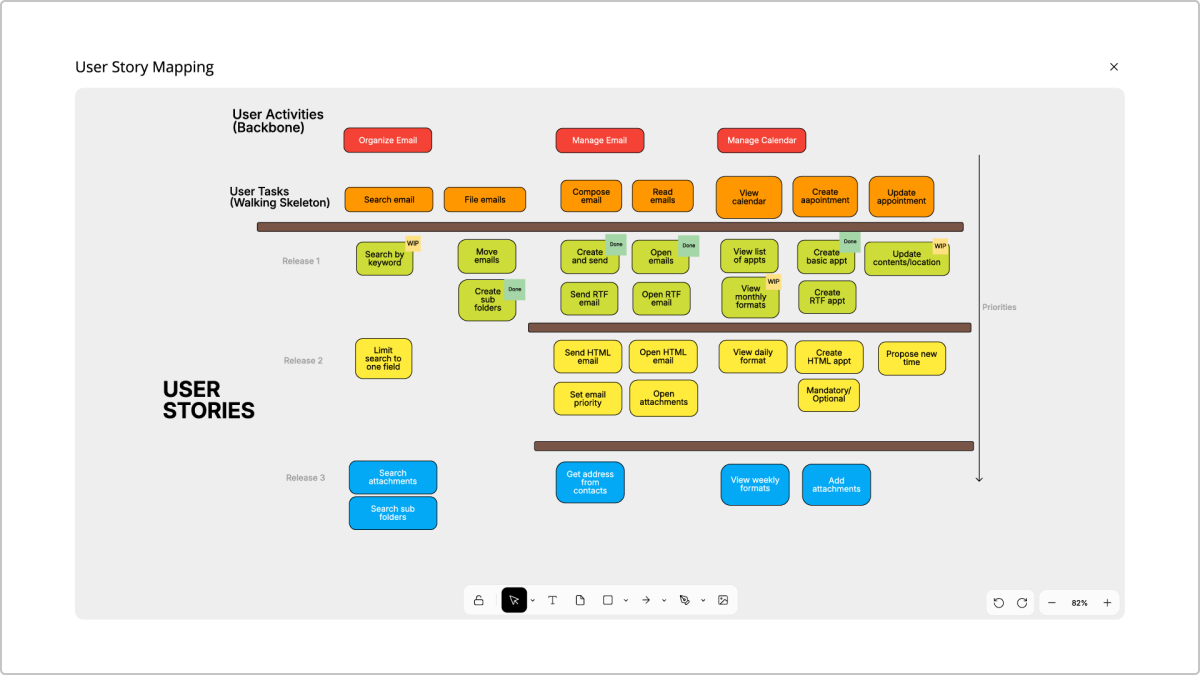

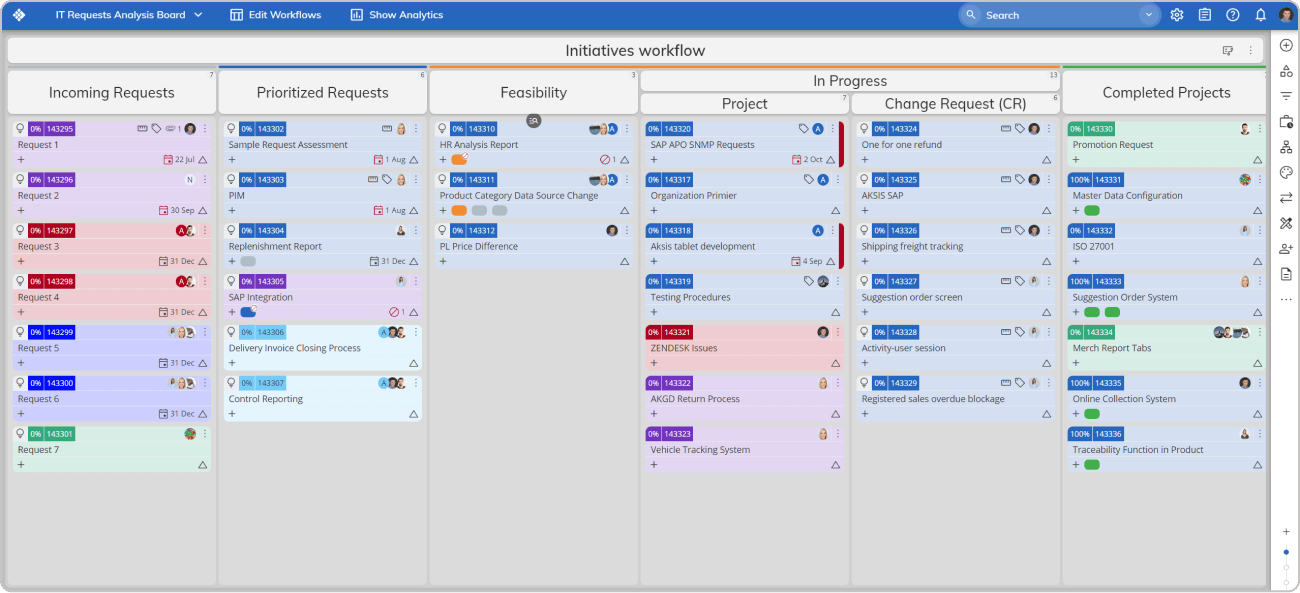
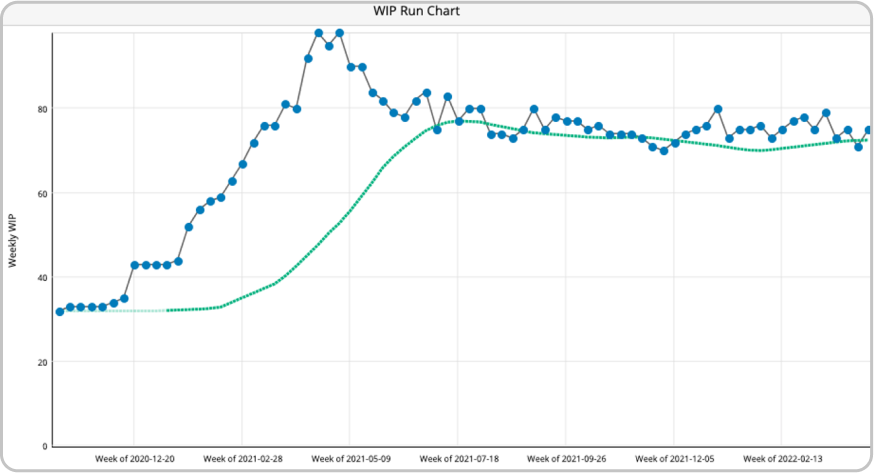 Average WIP (Work In Progress) of 80 items per week shown using the WIP Run Chart in Businessmap
Average WIP (Work In Progress) of 80 items per week shown using the WIP Run Chart in Businessmap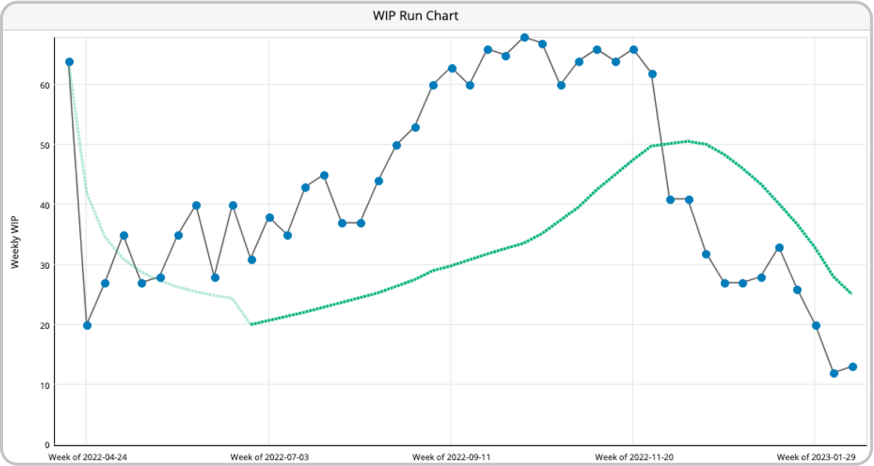 Average WIP (Work In Progress) drop shown after implementing the practice of limiting work
Average WIP (Work In Progress) drop shown after implementing the practice of limiting work

